A hierarchy is a social system in ancient Egypt. In Egypt, there were definite social classes which were dictated by an Egyptian’s profession. These social classes were represented by a pyramid (organized hierarchically). Social classes at the top of the pyramid subordinated classes with less power at the bottom.
The pharaoh, the Egyptian king, was at the top of Egyptian society. He was the embodiment of power and authority and the son of the god Ra. The vizier was the second most powerful official. He was the Pharaoh’s most trusted advisor. He ran all aspects of Ancient Egypt laws and government on the ruler’s behalf.

His position was very powerful and, like that of the king, it passed from father to son. The Vizier was also the judge of the high court. If you had a problem and it was not solved in the local courts, or in the provincial courts, you could bring your problem in front of the Vizier on a first come, first served basis.
Below the vizier was the high priests and noblemen whom the pharaoh appointed as his assistants, generals, and administrators, who together formed the government. Then came the Scribes, priests and minor officials. Scribes were people who could read, write, calculate, and keep records.
Also, there were scribes in the bureaucracy, temples, private estates and the judicial system. There were priests in all temples to every god in Egypt. Their duties involved carrying out the daily rituals and preparing offerings to appease the gods and ensure that the temple was running smoothly. Also at the same level were the doctors and engineers.
Egyptian Hierarchy
Next in the Egyptian Hierarchy were the craftsmen. Peasants and slaves were at the bottom of the pyramid. They supplied the hard labor that made complex agricultural society possible. Among the slaves were the Hebrews. Peasants were on the bottom of the social Egyptian Hierarchy and worked on the land which was owned by pharaohs, nobility or temples.
Ancient Egyptian peasants were tied to the land but could not be sold. They had to pay taxes and were free of military service but they were obliged to participate in public works such as construction works. However, there were also few independent small landowners who were only obliged to pay taxes.
Economically, the pharaoh was again the key figure in Egypt. He, in theory, owned all the land, people, and possessions. The pharaoh directly controlled the vast majority of the land, and it was managed by royal officials.
A small portion of the land was personally owned by nobles. Other lands were set aside for temples. The pharaoh collected a large amount of taxes that he used for large government projects such as building pyramids and temples.